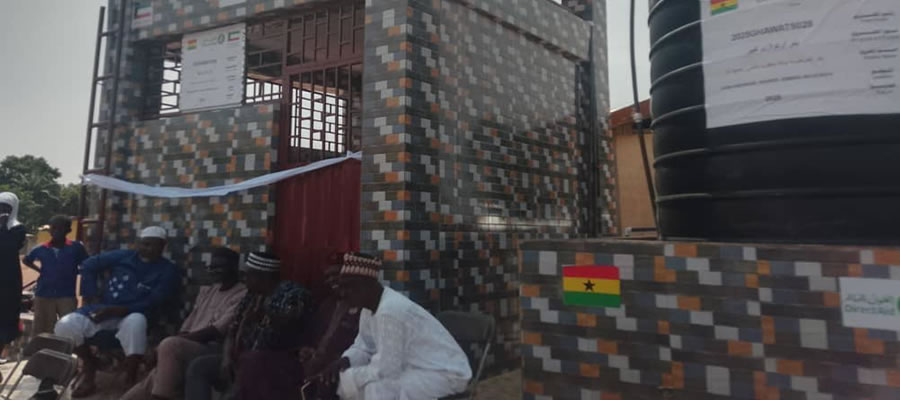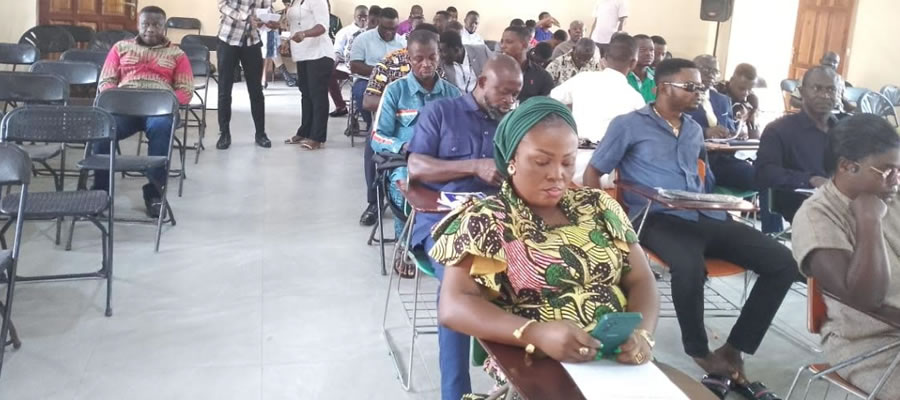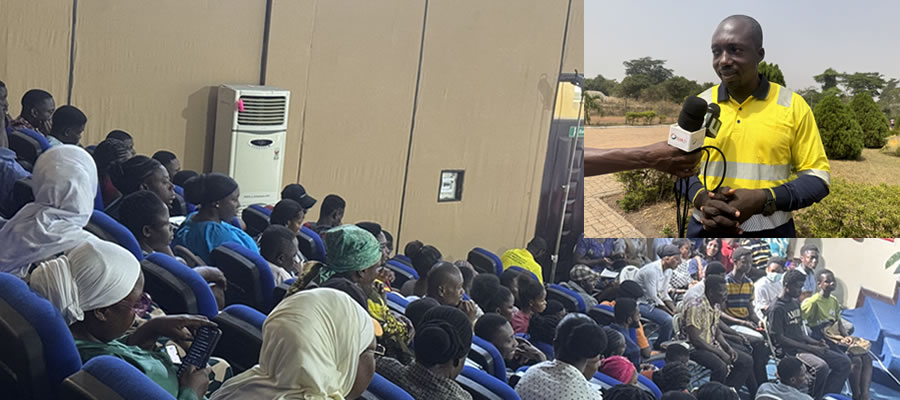

For the human resource to contribute effectively towards the development of any geographical entity, the health status of its human resource base should be assessed. When the health of a population improves the community can produce more with any given combination of skills, physical capital, and technological knowledge in certain growth sectors as agriculture, industry and among others. It is based on this that the health facilities, their spatial distribution, staffing, nutrition, and immunization programmes, and incidence of maternal and infant health problems are provided for a given town or community in order to have healthy life for improved productivity.
The others are the disease pattern, patronage of health facilities and the types of facilities patronized, issues relating to NHIS, HIV/AIDS and the problems and priorities of the health sector. Some of the measures being taking by the directorate to improve upon the health status of the people in the district include:
• To collaborate with the District Assembly, Ministry of Health and Traditional Authorities to improves on geographical and financial access to health services
• Expand and improve on health infrastructure
• Use Community Based Planning and Services (CHPS) to scale up Essential and Primary Health Services to the deprived and hard to reach areas
• Improve financial access to health services through promotion of District Wide Mutual Health Insurance Scheme
• Strengthen Preventive and Promotive Health Services in all the communities in the district
• Ensure easy access to Basic and Comprehensive Emergency Obstetric and Neonatal Care in the district
• Implement all relevant Government Health Policies at the district
The relationship between the directorate and the Ministry of Health, in the area of the development of health system in the district include:
• The Ministry provides policy guideline for the operations of the Directorate
• The Ministry has supervisory role at the District Health Directorate
• The Directorate is accountable to the Ministry through the Regional Health Directorate and National level of Ghana Health Service
The Directorate receives support from the Ministry to improve on
• Infrastructure and other capital intensive projects
• Staff recruitment and payment of salaries
• Further development of staff through sponsorship for further courses
• Equipment supply
The major problems facing the health system in the district are:
• Problem with environmental sanitation
• Inadequate supply of potable water in the communities
• Poor road network which hinders easy access to health care services
• Inadequate skilled and professional staff
• Inadequate staff accommodation
• Inadequate infrastructure
• Inadequate working equipment and instrument
Lack of essential equipment as
a. X-Ray
b. Ultrasound scan
c. Electrocardiography (ECG) machine
The future prospects of the directorate in the area of the development of the health system in the district are:
• Develop system to ensure easy access to Basic, Essential and Comprehensive Health Care on 24 hour basis
• Use CHPS as key strategy to extend essential and basic health services to deprived and hard to reach communities and areas
• Develop and expand Infrastructure at the following designated communities based on needs assessment:
Construct five (5) CHPS compounds at deprived communities
1. One (1) at (Buama-Dumase area,
2. One (1) at Nkyerepoaso areas
3. One (1) at Anum Agya area
4. One (1) at Timeabu area,
5. One(1)atAtia
Develop and expand Juaben Hospital (District Hospital)
1. New maternity unit
2. New Children ward
3. New theatre
4. X-Ray unit
5. Laboratory
6. Mortuary
Staff accommodation 8 unit staff quarters
1. Develop and expand Ejisu Hospital
2. Expansion on maternity unit
3. New Children ward
4. New theatre
5. X-Ray unit
6. Laboratory
7. Mortuary
• Staff accommodation 8 unit staff quarters
• Construct Health Centre at Tikrom
• Formally acquire all the land and premises of all the Government and Public Health facilities in the district
• Extension of Electricity to Achiase Health Centre, Bomfa Health Centre and Peminase Clinic
• Construction of DDHS bungalow at Ejisu
• Construction of 8 unit staff quarters for District Health Administration at Ejsiu.
The inadequacy of health facilities within the various settlements in the district have resulted in most of the people in the District patronizing health services outside the settlements in which they live even though most of these facilities are located in the district, about 59.9 percent of the population patronize health facilities outside the settlements they live whilst the other 40.1 percent patronize health facilities within the settlements the live.
The type of health facility highly patronized within the Ejisu Juaben district is the hospital constituting about 67.6 percent. Other health facilities like clinic, health post, traditional healers, maternity homes and drug store constitute about 27.1 percent, 0.3 percent, 0.7 percent, 2.0 percent and 2.3 percent respectively.
The average cost per visit is about 89165. Looking at the high cost per visit the health insurance scheme is a vital intervention to improve the health status of the people thus the need to intensify education to increase awareness and patronage. The average distance traveled by the inhabitants of the district to the health facilities is about 3.7 km whilst the average travel time is about 42.8 minutes.
About 80.3 percent of the population patronizes public health facilities whilst the other 19.7 percent patronize private health facilities. Those who patronize public health facilities gave the reason as low cost and proximity whilst those who attend private health facilities gave their reason to be the high quality of service rendered to them.
Frequency of visit to health facility
The study revealed that about 0.7% visit daily which may be due to the fact that their cases demands daily check ups, 1.3% visit weekly, 5.3% visit monthly, 4% visit annually and 88.7% visit occasionally. This implies that most of the people in the District do not patronize health facilities regularly. This can affect the health status of the people since there is the need to under go regular check ups even if one is not sick. There is therefore the need to undertake public education in the District on the need to go for regular check ups.
Problem with the usage facility
According to the survey, some problems associated with the use of health facilities in the District include long queues, poor attitude of staff towards patients, high cost, long distance and inadequate health personnel constituting 35.5%, 11.5%, 38%, 9.4%, 5.6% respectively. High cost of attendance is the dominant problem and could be the reason why people only visit these health facilities occasionally. This implies that even though the people might be sick or have health problem, they only visit when their situation gets worse. The effective implementation of the NHIS can also help improve hospital attendance.
Means of Transport to health facility
The means of transportation to these health facilities are either by vehicle by bicycle or on foot. However, the use of vehicle dominates with 65% of the people using vehicle as the means of transport indicating that most of the people either travel to communities outside their communities but within the District or outside the District which could also account for the reason why about 88.7% visit health facilities occasionally. This could also account for the problems of high cost associated with the use of health facility. This implies that some communities lack health facilities and its’ indigenes have to travel long distances to receive medical attention.
Awareness about NHIS
The survey revealed that about 93.7% of the people are aware of the National Health Insurance scheme whilst 6.3% are unaware. This implies that there is high awareness rate about the Nation Health Insurance scheme. Even though about 93.7% are aware of the existence of the scheme and its usefulness, only 46% the people have registered. The 56% of the people who have not registered attributed it to reasons like financial, political reasons, poor access, time factor, ignorance and scheme does not cover all ailments constituting 65.6%,5.0%, 19.4%, 3.1%, 6.3% and 0.6% respectively.
This implies that even though the awareness rate is high, the participation rate is low due to the reasons explains above thus the need to intensify public education on the need to register for the NHIS.
Awareness about HIV/AIDS
About 99% of the people in the district are aware of the dreadful or deadly disease HIV/AIDS whilst only 1% claims they are unaware. This will help in educating the people on the prevention of the disease.
Knowledge of mode of transmission
The survey revealed that about 85.2% of the people know that the disease is transmitted though unprotected sex, 13.5% know that it can be got through blood transfusion, 0.7% also think it is a spiritual disease and 0.7% are also aware that the disease is transmitted through usage of sharp objects already used by affected person. This implies that, since awareness rate is high and the knowledge of means or mode of transmission is also very high it will be easier to sensitize the public on the prevention of the disease.
HIV/AIDS Prevention
As already said, since awareness rate is high and knowledge of mode transmission also high, prevention would definitely be high as well. About 94.3% claim they are doing something to prevent the disease whilst 5.7% also claim they are doing nothing to prevent the disease. This high, the 5.7% must also be educated to know the need to prevent the disease.
Means of Prevention
The survey revealed that about 36.3% use abstinence as a means of prevention of the disease, 36.3% also use contraceptives as a means of preventing the disease, 23.9% rely on faithfulness to their partner to prevent the disease and 3.5% avoid the use of sharp objects used by to prevent the disease.
Date Created : 11/27/2017 2:47:43 AM













 facebook
facebook
 twitter
twitter
 Youtube
Youtube
 +233 593 831 280
+233 593 831 280 0800 430 430
0800 430 430 GPS: GE-231-4383
GPS: GE-231-4383 info@ghanadistricts.com
info@ghanadistricts.com Box GP1044, Accra, Ghana
Box GP1044, Accra, Ghana